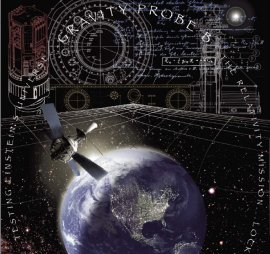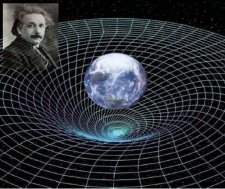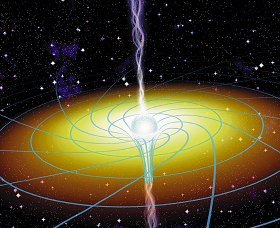|
Gravity Probe B has left Earth to measure a subtle yet long-sought
force of Nature.
by Dr Tony Phillips
NASA's Gravity Probe
B spacecraft left Earth on April 20th 2004 in search of a force
of nature, long suspected but never proven: gravitomagnetism.
Gravitomagnetism is
produced by stars and planets when they spin. "It's similar
in form to the magnetic field produced by a spinning ball of charge,"
explains physicist Clifford Will of Washington University (St. Louis).
Replace charge with mass, and magnetism becomes gravitomagnetism.
We don't feel gravitomagnetism
as we go about our everyday lives on Earth, but according to Einstein's
theory of General Relativity it's real. When a planet (or a star
or a black hole ... or anything massive) spins it pulls space and
time around with it, an action known as "frame dragging."
The fabric of spacetime twists like a vortex. Einstein tells us
that all gravitational forces correspond to a bending of spacetime;
the "twist" is gravitomagnetism.
What does gravitomagnetism
do? "It can make the orbits of satellites precess," says
Will, "and it would cause a gyroscope placed in Earth orbit
to wobble." Both effects are small and difficult to measure.

more
Gravity
Probe B is now in Earth orbit
|
Researchers led by
physicist Ignazio Ciufolini have tried to detect the gravitomagnetic
precession of satellite orbits. For their study, they used the Laser
Geodynamic Satellites, LAGEOS & LAGEOS II, two 60 cm diameter
balls studded with mirrors. Precise laser ranging of the pair allows
their orbits to be monitored. The researchers did find a small amount
of precession consistent (at the 20% level) with gravitomagnetism.
But there's a problem: Earth's equatorial bulge pulls on the satellites,
too, and causes a precession billions of times greater than gravitomagnetism.
Did Ciufolini et al. subtract that huge pull with enough
precision to detect gravitomagnetism? Many scientists accept their
results, notes Will, while others are skeptical.
Gravity Probe B, developed
by scientists at Stanford University, NASA and Lockheed Martin,
will do the experiment differently, using gyroscopes.
The spacecraft circles
Earth in a polar orbit 400 miles high. Onboard are four gyroscopes,
each one a sphere, 1.5 inches in diameter, suspended in vacuum and
spinning ten thousand times per minute. If Einstein's equations
are correct and gravitomagnetism is real, the spinning gyroscopes
should wobble as they orbit the earth. Their spin axes will shift,
little by little, until a year from now they point 42 milli-arcseconds
away from where they started. Gravity Probe B can measure this angle
with a precision of 0.5 milli-arcseconds, or about 1%.
Any angle measured
in milli-arcseconds is tiny. Consider this: One arcsecond equals
1/3600th of a degree. One milli-arcsecond is
1000 times smaller than that. The half milli-arcsecond precision
expected for Gravity Probe B corresponds to the thickness of a sheet
of paper held edge-on 100 miles away.
Sensing wobbles so
small is a great challenge, and scientists working on Gravity Probe
B had to invent whole new technologies to make it possible.
A National Research
Council panel, among them Cliff Will, wrote in 1995, "In the
course of its design work on Gravity Probe B, the team has made
brilliant and original contributions to basic physics and technology.
Its members were among the first to measure the London moment of
a spinning superconductor, the first to exploit the superconducting
bag method for excluding magnetic flux, and the first to use a 'porous
plug' for confining superfluid helium without pressure buildup.
They invented and proved the concept of a drag-free satellite, and
most recently some members of the group have pioneered differential
use of the Global Positioning System (GPS) to create a highly reliable
and precise aircraft landing system."

An
artist's concept of twisted spacetime around Earth.
|
Not bad for basic research.
Physicists are both
anxious and excited by Gravity Probe B. They're anxious because
gravitomagnetism might not be there. Einstein's theory could be
wrong (a possibility held unlikely by most), and that would spark
a revolution in physics. They're excited for the same reason. Everyone
wants to be on hand for the next great advance in science.
Near Earth, gravitomagnetism
is weak. That's why the Gravity Probe B gyroscopes wobble only 42
milli-arcseconds. But gravitomagnetism could be powerful in other
parts of the Universe--for instance, "near a spinning black
hole or a neutron star," says Will. A typical neutron star
packs more mass than the Sun into a ball only 10 km wide, and it
spins a hundred thousand times faster than Earth. The gravitomagnetic
field there could be very strong.
Astronomers might have
already observed the effects of gravitomagnetism. Some black holes
and neutron stars shoot bright jets of matter into space at nearly
light speed. These jets come in pairs, oppositely directed, as if
they emerge from the poles of a rotating object. Theorists think
the jets could be powered and collimated by gravitomagnetism.

Credit: Joe Bergeron of Sky & Telescope
magazine
An
artist's impression of space and time twisting around
a spinning black hole.
|
In addition, black
holes are surrounded by disks of infalling matter called "accretion
disks," so hot they glow in the x-ray region of the electromagnetic
spectrum. There's mounting evidence, gathered by X-ray telescopes
such as NASA's Chandra X-ray Observatory, that these disks wobble,
much like the gyroscopes on Gravity Probe B are expected to do.
Gravitomagnetism again? Perhaps.
Here in our solar system
gravitomagnetism is, at best, feeble. This raises the question,
what do we do with gravitomagnetism once we've found it? The same
question was posed, many times, in the 19th century when Maxwell,
Faraday and others were exploring electromagnetism. What use could
it be?
Today we're surrounded
by the benefits of their research. Light bulbs. Computers. Washing
machines. The Internet. The list goes on and on. What will gravitomagnetism
be good for? Is it just "another milestone on the path of our
natural quest to understand nature?" wonders Will. Or something
unimaginably practical? Time will tell.
Please Note - Physicist
Clifford Will, who was interviewed for this story, is not a member
of the Gravity Probe B team. He is, however, an expert in General
Relativity and an independent reviewer of the Gravity Probe B project
who has sat on several mission review panels at the invitation of
NASA.
|
